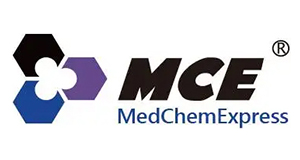Taurodeoxycholate-d6 (sodium salt), CAS 2687960-92-3
Taurodeoxycholate-d6 (sodium salt), CAS 2687960-92-3
SKU
MEXHY-128853S-1
Packaging Unit
1 mg
Manufacturer
MedChemExpress
Availability:
loading...
Price is loading...
Product Description: Taurodeoxycholate-d6 sodium salt is a bile salt-related anionic detergent. Taurodeoxycholate-d6 sodium salt is formed in the liver by conjugation of deoxycholate with Taurine (HY-B0351). Taurodeoxycholate-d6 sodium salt is used for isolation of membrane proteins including inner mitochondrial membrane proteins. Taurodeoxycholate-d6 (TDCA) exhibits anti-inflammatory and neuroprotective effects[1][2][3][9][10].
Applications: COVID-19-immunoregulation
Formula: C26H39D6NNaO6S
References: [1]Villavicencio-Queijeiro A, et al. The fully-active and structurally-stable form of the mitochondrial ATP synthase of Polytomella sp. is dimeric. J Bioenerg Biomembr. 2009 Feb;41(1):1-13. /[2]Kispal G, et al. Isolation and characterization of 3-hydroxyacyl coenzyme A dehydrogenase-binding protein from pig heart inner mitochondrial membrane. J Biol Chem. 1986 Oct 25;261(30):14209-13./[3]Choi HJ, et al. Evaluation of acute and subacute toxicity of sodium Taurodeoxycholate in rats. Drug Chem Toxicol. 2021 May;44(3):268-276./[4]Sato H, et al. Novel potent and selective bile acid derivatives as TGR5 agonists: biological screening, structure-activity relationships, and molecular modeling studies. J Med Chem. 2008 Mar 27;51(6):1831-41./[5]Gertzen CG, et al. Mutational mapping of the transmembrane binding site of the G-protein coupled receptor TGR5 and binding mode prediction of TGR5 agonists. Eur J Med Chem. 2015 Nov 2;104:57-72./[6]Benz C, et al. Effect of tauroursodeoxycholic acid on bile acid-induced apoptosis in primary human hepatocytes. Eur J Clin Invest. 2000 Mar;30(3):203-9./[7]Xie Q, et al. Effect of tauroursodeoxycholic acid on endoplasmic reticulum stress-induced caspase-12 activation. Hepatology. 2002 Sep;36(3):592-601./[8] Yamaguchi J, et al. Taurodeoxycholate increases intestinal epithelial cell proliferation through c-myc expression. Surgery. 2004 Feb;135(2):215-21./[9]Zou Y, et al. Taurodeoxycholate ameliorates DSS-induced colitis in mice. Int Immunopharmacol. 2023 Sep;122:110628./[10]Keene CD, et al. A bile acid protects against motor and cognitive deficits and reduces striatal degeneration in the 3-nitropropionic acid model of Huntington's disease. Exp Neurol. 2001 Oct;171(2):351-60. /[11] Keene CD, et al. Tauroursodeoxycholic acid, a bile acid, is neuroprotective in a transgenic animal model of Huntington's disease. Proc Natl Acad Sci U S A. 2002 Aug 6;99(16):10671-6. /[12]Chang S, et al. Taurodeoxycholate Increases the Number of Myeloid-Derived Suppressor Cells That Ameliorate Sepsis in Mice. Front Immunol. 2018 Sep 18;9:1984.
CAS Number: 2687960-92-3
Molecular Weight: 528.73
Research Area: Inflammation/Immunology; Neurological Disease
Solubility: 10 mM in DMSO
Target: Apoptosis;Endogenous Metabolite;G protein-coupled Bile Acid Receptor 1;NF-κB;PARP;PKA
Applications: COVID-19-immunoregulation
Formula: C26H39D6NNaO6S
References: [1]Villavicencio-Queijeiro A, et al. The fully-active and structurally-stable form of the mitochondrial ATP synthase of Polytomella sp. is dimeric. J Bioenerg Biomembr. 2009 Feb;41(1):1-13. /[2]Kispal G, et al. Isolation and characterization of 3-hydroxyacyl coenzyme A dehydrogenase-binding protein from pig heart inner mitochondrial membrane. J Biol Chem. 1986 Oct 25;261(30):14209-13./[3]Choi HJ, et al. Evaluation of acute and subacute toxicity of sodium Taurodeoxycholate in rats. Drug Chem Toxicol. 2021 May;44(3):268-276./[4]Sato H, et al. Novel potent and selective bile acid derivatives as TGR5 agonists: biological screening, structure-activity relationships, and molecular modeling studies. J Med Chem. 2008 Mar 27;51(6):1831-41./[5]Gertzen CG, et al. Mutational mapping of the transmembrane binding site of the G-protein coupled receptor TGR5 and binding mode prediction of TGR5 agonists. Eur J Med Chem. 2015 Nov 2;104:57-72./[6]Benz C, et al. Effect of tauroursodeoxycholic acid on bile acid-induced apoptosis in primary human hepatocytes. Eur J Clin Invest. 2000 Mar;30(3):203-9./[7]Xie Q, et al. Effect of tauroursodeoxycholic acid on endoplasmic reticulum stress-induced caspase-12 activation. Hepatology. 2002 Sep;36(3):592-601./[8] Yamaguchi J, et al. Taurodeoxycholate increases intestinal epithelial cell proliferation through c-myc expression. Surgery. 2004 Feb;135(2):215-21./[9]Zou Y, et al. Taurodeoxycholate ameliorates DSS-induced colitis in mice. Int Immunopharmacol. 2023 Sep;122:110628./[10]Keene CD, et al. A bile acid protects against motor and cognitive deficits and reduces striatal degeneration in the 3-nitropropionic acid model of Huntington's disease. Exp Neurol. 2001 Oct;171(2):351-60. /[11] Keene CD, et al. Tauroursodeoxycholic acid, a bile acid, is neuroprotective in a transgenic animal model of Huntington's disease. Proc Natl Acad Sci U S A. 2002 Aug 6;99(16):10671-6. /[12]Chang S, et al. Taurodeoxycholate Increases the Number of Myeloid-Derived Suppressor Cells That Ameliorate Sepsis in Mice. Front Immunol. 2018 Sep 18;9:1984.
CAS Number: 2687960-92-3
Molecular Weight: 528.73
Research Area: Inflammation/Immunology; Neurological Disease
Solubility: 10 mM in DMSO
Target: Apoptosis;Endogenous Metabolite;G protein-coupled Bile Acid Receptor 1;NF-κB;PARP;PKA
| SKU | MEXHY-128853S-1 |
|---|---|
| Manufacturer | MedChemExpress |
| Manufacturer SKU | HY-128853S-1 |
| Package Unit | 1 mg |
| Quantity Unit | STK |
| Product information (PDF) | Download |
| MSDS (PDF) |
|

 Deutsch
Deutsch







